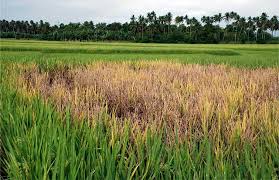The following are the direct effects and the indirect effects of pests on crop plants;
1. Direct effect of insect feeding
Leaves eaten, with subsequent reduction in assimilative tissue and hindrance of growth; examples aregrasshoppers, caterpillars, sawfly larvae, leaf-cutting ants, leaf beetle and some weevil.
Leaves rolled and webbed, and eaten; examples are larvae of skippers, and all Lepidoptera.
Leaves mined with either tunnel or blotch mines.
Buds eaten, destroying either the growing point of young flowers and fruit.
Flowers and young fruit eaten, as by pollen beetle, blister beetles.
Fruits and seeds eaten or bored and destroyed, as by sorghum midge larvae, pea pod borers, maize weevil, coffee berry borer and various fruit flies.
Fruits bored and caused to fall prematurely for example mango fruit fly, and coffee fruit fly.
Stems of both woody and herbaceous plants bored, with subsequent death of the distal part of the stem, for example Earias spp. in cotton stem.
Stems of seedlings bored, producing a dead-heart; for example Athergona spp. larvae in cereal seedlings, and Chilo spp. larvae in cereals.
Stem of woody plants ring-barked, as done by Anthores spp. on coffee.
Roots eaten, causing a loss of water and nutrient absorbing tissue, as by chafer grubs and some weevil larvae.
Tubers and corms bored, leading to a reduction of stored food material, and impairing both storage properties and next season’s growth; examples are Cylas spp. weevils in sweet potato tubers, yam beetles and potato tuber moth larvae.
Read Also : Definitions, Classification, and Description of Important Pests of Crops
1b. Damage by insects with piercing and chewing mouth parts and mites
Loss of plant vigour due to removal of excessive amounts of sap, resulting in extreme cases in wilting, followed by stunting of growth; for example most aphid species, and whiteflies on a range of crop plants.
Cause leaf-curling and deformation, as shown by aphids, thrips, mealybugs, white/black flies and jassids.
Cause premature leaf-fall, as do many diaspidid scales.

Cause leaf and fruit scarification by rupturing epidermal cells and removing sap; as by spider mites and many thrips.
Toxic saliva injected by feeding bugs causes premature fruit-fall in coconut and abortion of young cotton bolls, etc.
Provides physical entry points for pathogenic fungi and bacteria.
2. Indirect Effect of Insects on Crops
Insects can make the crop more difficult to cultivate/harvest.
They may distort the plant as do Eariasspp. larvae on cotton.
They may delay crop maturity, as do the bollworms in cotton, which makes the plant to develop a spreading habit thus, making weeding and spraying difficult.
Grain in cereal crops may become dwarfed or distorted.
Insect infestation results in contamination and loss of quality in the crop. The loss of quality may be in nutritional value or in marketability.
2b. Transmission of disease organisms
Cassava mosaic, tobacco mosaic and banana bunchy to p are typical examples of crop diseases that are transmitted by insect vector.
Mechanical or passive transmission takes place through lesions in the cuticle caused by feeding. The pathogen, usually a fungus or bacterium, may be carried on the proboscis of the bug or on the body of a tunneling insect.
Read Also : 10 Amazing Health Benefits of Cucumber Fruit

